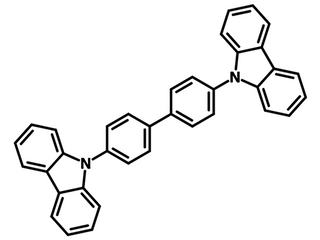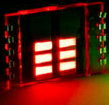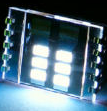CBP, 4,4′-Bis(N-carbazolyl)-1,1′-biphenyl, is one of the most widely-used host materials for efficient fluorescent and phosphorescent organic light-emitting diodes with high hole mobility. This is due to its electron-rich property from two carbazolyl units.
It has been demonstrated that CBP can efficiently host green, yellow and red phosphorescent emitters with triplet energies smaller than that of CBP (ET = 2.6 eV) [1].
General Information
|
CAS number
|
58328-31-7
|
|
Chemical formula
|
C36H24N2
|
|
Molecular weight
|
484.59 g/mol
|
|
HOMO/LUMO
|
HOMO 6.0 eV, LUMO 2.9 eV
|
|
Synonyms
|
CBP, 4,4′-Bis(9-carbazolyl)-1,1′-biphenyl, 4,4-N,N′-Dicarbazole-1,1′-biphenyl,DCBP, BSBCz, BSB-Cz
|
|
Classification / Family
|
Carbazole derivatives, Hole-injection layer materials, Hole transport layer materials, Hole blocking layer materials, Phosphorescent host materials, Light-emitting fiodes, Organic electronics, Sublimed materials
|
Product Details
|
Purity
|
> 99.5% (sublimed)
|
|
Melting point
|
281-285 (lit.) °C
|
|
Appearance
|
White powder
|
*Sublimation is a technique used to obtain ultra pure-grade chemicals. For more details about sublimation, please refer to the Sublimed Materials page.
Chemical Structure
 Chemical structure of CBP, CAS 58328-31-7
Chemical structure of CBP, CAS 58328-31-7
Device Structure(s)
|
Device structure
|
ITO/MoO3 (3 nm)/CBP: 20 wt% Ir(ppy)3: 4 wt% FIrpic (30 nm)/TAZ (50 nm) [8]
|
|
Colour
|
Green 
|
|
Max. Luminance
|
27,524 cd/m2
|
|
Max. Current Efficiency
|
71.2 cd/A
|
|
Device structure
|
ITO /TAPC/(1wt% DPB:99wt% tri-PXZ-TRZ*):CBP (15:85)/LiF/Al [6]
|
|
Colour
|
Red 
|
|
Max EQE
|
17.5%
|
|
Max. Power Efficiency
|
28 lm W−1
|
|
Device structure
|
ITO/MO3 (1 nm)/CBP (35 nm)/8 wt% Ir(ppy)2(acac):CBP/TPBi (65 nm)/LiF/Al (100 nm) [7]
|
|
Colour
|
Green 
|
|
EQE at 100 cd/m2
|
23.4
|
|
Current Efficiency at 100
cd/m2
|
81 cd/A
|
|
Power Efficiency at 100
cd/m2
|
78.0 lm W−1
|
|
Device structure
|
ITO/MoOx (2 nm)/m-MTDATA: MoOx (30 nm, 15 wt.%)/m-MTDATA (10 nm)/Ir(ppz)3(10 nm)/CBP:PO-01* (3 nm, 6 wt.%)/Ir(ppz)3 (1 nm)/DBFDPOPhCz*:FIrpic (10 nm,10 wt.%)/Bphen (36 nm)/LiF (1 nm)/Al [9]
|
|
Colour
|
White 
|
|
Max. EQE
|
12.2%
|
|
Max. Current Efficiency
|
42.4 cd/A
|
|
Max. Power Efficiency
|
47.6 lm W−1
|
|
Device structure
|
ITO/NPB (30 nm)/CBP:8 wt% (t-bt)2Ir(acac)* (15 nm)/BPhen(35 nm)/LiF (1 nm)/CoPc:C60 (4:1) (5 nm)/MoO3(5 nm)/NPB(30 nm)/CBP:8 wt% (t-bt)2Ir(acac)* (15 nm)/BPhen (35 nm)/Mg:Ag (100 nm) [10]
|
|
Colour
|
Yellow 
|
|
Max. EQE
|
16.78%
|
|
Max. Luminance
|
42,236 cd/m2
|
|
Max. Current Efficiency
|
50.2 cd/A
|
|
Max. Power Efficiency
|
12.9 lm W−1
|
|
Device structure
|
ITO/NPD* (40 nm)/9%-Ir(piq)3:CBP (20 nm)/BPhen (50 nm)/KF (1 nm)/Al [11]
|
|
Colour
|
Red 
|
|
Max. Luminance
|
11,000 cd/m2
|
|
Max EQE
|
10.3%
|
|
Max. Power Efficiency
|
8.0 lm W−1
|
|
Device structure
|
ITO/0.4 wt% F4TCNQ doped α NPD (30 nm)/ 5 wt% Ir(ppy)3 doped CBP (50 nm)/BPhen (30 nm)/20 wt% TCNQ mixed BPhen (1.5 nm)/Al [12]
|
|
Colour
|
Green 
|
|
Luminance at 15 V
|
1,320 cd/m2
|
|
Power Efficiency at 14 V
|
56.6 lm W−1
|
|
Current Efficiency at 14 V
|
23.17 cd/A
|
|
Device structure
|
ITO/F4TCNQ (3 nm)/MeO-Spiro-TPD (27 nm)/CBP + BCzVbi* (50 nm)/BPhen (10 nm)/TCNQ mixed BPhen (1.5 nm)/Al [13]
|
|
Colour
|
Red 
|
|
Luminance at 10 mA/cm2
|
1,790 cd/m2
|
|
Power Efficiency at 10 mA/cm2
|
4.65 lm W−1
|
|
Current Efficiency at 10 mA/cm2
|
18.0 cd/A
|


 Chemical structure of CBP, CAS 58328-31-7
Chemical structure of CBP, CAS 58328-31-7
![]()
![]()
![]()
![]()
![]()
![]()
![]()
![]()